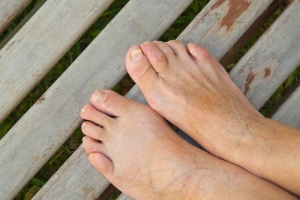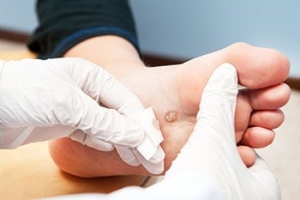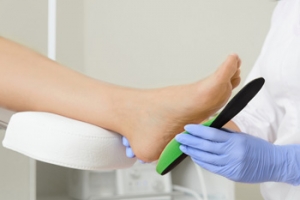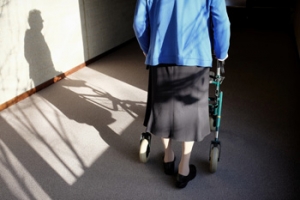Connect With Us
Featured Articles

Treatment for Flexible and Rigid Hammertoes
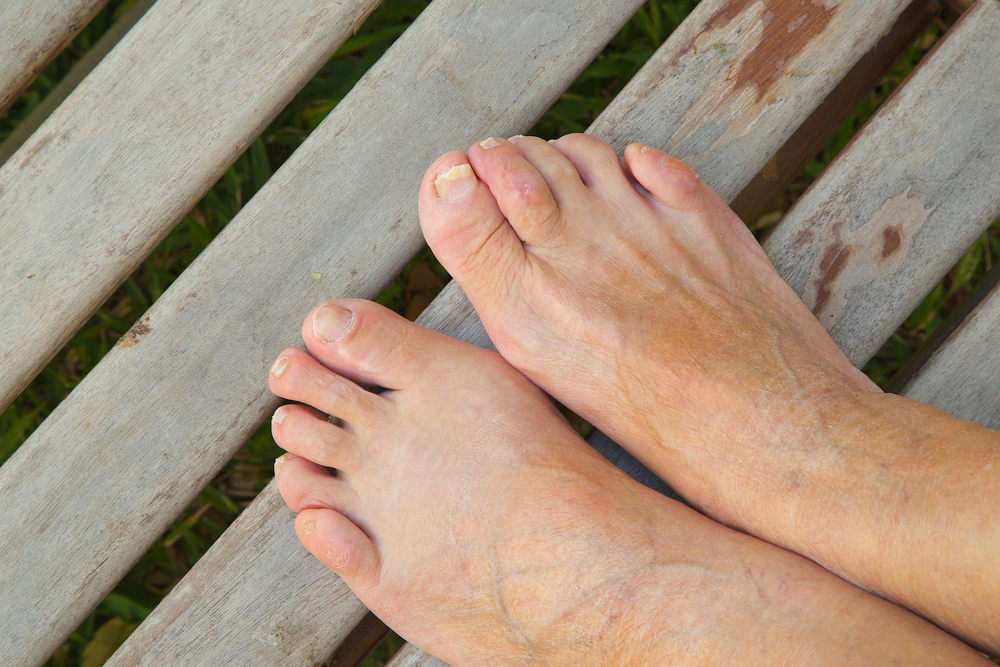 Hammertoes are a foot deformity in which one or more of the smaller toes are bent at the middle joint, resulting in a hammer-like appearance. In the early stages of this condition, the hammertoes are usually flexible and the patient can move their toe joints. Flexible hammertoes can often be treated without surgery. Changing your footwear, doing toe strengthening exercises, and putting a pad over the joint to stop it from rubbing against the shoes can all help relieve symptoms. Having rigid hammertoes means that the toe joints are no longer movable. This can be treated conservatively through footwear modifications and custom orthotics, or surgically. For more information about hammertoes, please consult with a podiatrist.
Hammertoes are a foot deformity in which one or more of the smaller toes are bent at the middle joint, resulting in a hammer-like appearance. In the early stages of this condition, the hammertoes are usually flexible and the patient can move their toe joints. Flexible hammertoes can often be treated without surgery. Changing your footwear, doing toe strengthening exercises, and putting a pad over the joint to stop it from rubbing against the shoes can all help relieve symptoms. Having rigid hammertoes means that the toe joints are no longer movable. This can be treated conservatively through footwear modifications and custom orthotics, or surgically. For more information about hammertoes, please consult with a podiatrist.
Hammertoe
Hammertoes can be a painful condition to live with. For more information, contact Dr. Howard Horowitz from Bowie Foot & Ankle . Our doctor will answer any of your foot- and ankle-related questions.
Hammertoe is a foot deformity that affects the joints of the second, third, fourth, or fifth toes of your feet. It is a painful foot condition in which these toes curl and arch up, which can often lead to pain when wearing footwear.
Symptoms
- Pain in the affected toes
- Development of corns or calluses due to friction
- Inflammation
- Redness
- Contracture of the toes
Causes
Genetics – People who are genetically predisposed to hammertoe are often more susceptible
Arthritis – Because arthritis affects the joints in your toes, further deformities stemming from arthritis can occur
Trauma – Direct trauma to the toes could potentially lead to hammertoe
Ill-fitting shoes – Undue pressure on the front of the toes from ill-fitting shoes can potentially lead to the development of hammertoe
Treatment
Orthotics – Custom made inserts can be used to help relieve pressure placed on the toes and therefore relieve some of the pain associated with it
Medications – Oral medications such as anti-inflammatories or NSAIDs could be used to treat the pain and inflammation hammertoes causes. Injections of corticosteroids are also sometimes used
Surgery – In more severe cases where the hammertoes have become more rigid, foot surgery is a potential option
If you have any questions please contact our office located in Bowie, MD . We offer the newest diagnostic and treatment technologies for all your foot and ankle needs.
Hammertoe
Hammertoe is a foot deformity that occurs due to an imbalance in the tendons, muscles, or ligaments that are responsible for holding the toes in their normal position. This condition may be caused by poor footwear, foot structure, trauma, and disease. The most common solution for hammertoe is to relieve the pain by changing your footwear and wearing orthotics. In severe cases, surgery may be required.
The shoes that are most likely to cause hammertoe are high heeled shoes or shoes that are too tight in the toe box. Tight shoes will force your toes to crowd together in a curled position. This position will likely continue when you take your shoes off. Another cause is trauma. When you stub your toe, you are increasing the chance that you will develop hammertoe.
There are risk factors that may make you more likely to develop this condition. Women are more likely to have the condition compared to men, and it is also more likely to appear in those who are older in age.
Many different foot problems can be avoided by wearing shoes that have adjustability, adequate toe room, and low heels. Furthermore, if you want to buy new shoes, you should look to purchase them at the end of the day and make sure you know your correct size. The importance of buying shoes at the end of the day is that your feet swell as the day progresses. You should also ensure that you are wearing your correct size because your shoe size may change as you grow older.
To diagnose someone with hammertoe, your podiatrist will need to conduct a thorough examination of your foot. Your doctor may even order an x-ray to evaluate the bones and joints of your feet and toes.
If you have hammertoe, your podiatrist may recommend that you wear shoes that fit you better along with inserts to place inside them. Additionally, he or she may suggest special exercises for you to perform to stretch your toes. One helpful exercise it to pick up marbles with your feet or crumple a towel with your toes.
Prior to meeting with your podiatrist, it will be helpful to make a list of all the symptoms you are experiencing. You should also make a note of medications you are taking and important personal information about your medical history.
What Do Plantar Warts Look Like?
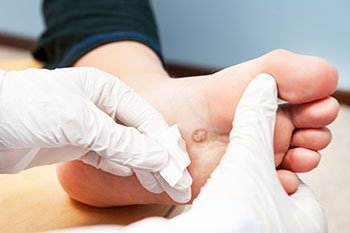 Warts on the bottom of the feet, known as plantar warts, are caused by a viral infection called HPV. Plantar warts can appear anywhere on the bottom of the foot. They are more common on the foot’s pressure points, such as the heel, toes, and balls of the foot. A plantar wart may appear by itself, or appear as multiple warts. Sometimes, multiple warts come together to form what looks like a firm, thickened plaque over a specific area on the bottom of the foot. The warts themselves may be gray, brown, yellow, or flesh-colored. Often tiny black dots, which are actually small, dilated blood vessels, can be seen on the surface of the warts. Sometimes plantar warts can become calloused or grow into the foot, which can make walking uncomfortable. If you have warts on the bottom of your feet, please consult with a podiatrist.
Warts on the bottom of the feet, known as plantar warts, are caused by a viral infection called HPV. Plantar warts can appear anywhere on the bottom of the foot. They are more common on the foot’s pressure points, such as the heel, toes, and balls of the foot. A plantar wart may appear by itself, or appear as multiple warts. Sometimes, multiple warts come together to form what looks like a firm, thickened plaque over a specific area on the bottom of the foot. The warts themselves may be gray, brown, yellow, or flesh-colored. Often tiny black dots, which are actually small, dilated blood vessels, can be seen on the surface of the warts. Sometimes plantar warts can become calloused or grow into the foot, which can make walking uncomfortable. If you have warts on the bottom of your feet, please consult with a podiatrist.
Plantar warts can be very uncomfortable. If you need your feet checked, contact Dr. Howard Horowitz from Bowie Foot & Ankle . Our doctor will assist you with all of your foot and ankle needs.
About Plantar Warts
Plantar warts are the result of HPV, or human papillomavirus, getting into open wounds on the feet. They are mostly found on the heels or balls of the feet.
While plantar warts are generally harmless, those experiencing excessive pain or those suffering from diabetes or a compromised immune system require immediate medical care. Plantar warts are easily diagnosed, usually through scraping off a bit of rough skin or by getting a biopsy.
Symptoms
- Lesions on the bottom of your feet, usually rough and grainy
- Hard or thick callused spots
- Wart seeds, which are small clotted blood vessels that look like little black spots
- Pain, discomfort, or tenderness of your feet when walking or standing
Treatment
- Freezing
- Electric tool removal
- Laser Treatment
- Topical Creams (prescription only)
- Over-the-counter medications
To help prevent developing plantar warts, avoid walking barefoot over abrasive surfaces that can cause cuts or wounds for HPV to get into. Avoiding direct contact with other warts, as well as not picking or rubbing existing warts, can help prevent the further spread of plantar warts. However, if you think you have developed plantar warts, speak to your podiatrist. He or she can diagnose the warts on your feet and recommend the appropriate treatment options.
If you have any questions please feel free to contact our office located in Bowie, MD . We offer the newest diagnostic and treatment technologies for all your foot and ankle needs.
All About Plantar Warts
Plantar warts are warts that are only found on the feet, hence the term “plantar”, which means “relating to the foot.” They are caused by the human papillomavirus, or HPV, and occur when this virus gets into open wounds on the feet. The warts themselves are hard bumps on the foot. They are easily recognizable, mostly found on the heels or ball of the foot. Plantar warts are non-malignant, but they can cause some pain, discomfort, and are often unsightly. Removing them is a common step toward treating them.
Plantar warts can cause some pain while standing, sometimes felt as tenderness on the sole of your foot. Unless the wart has grown into the foot behind a callus, you will be able to see the fleshy wart. A podiatrist should only be consulted if there is an excessive amount of pain. Plantar warts are not cancerous or dangerous, but they can affect your walking and continually reappear. Anyone who suffers from diabetes or a compromised immune system disease should seek out care immediately.
Podiatrists are easily able to diagnose plantar warts. They usually scrape off a tiny bit of the rough skin to make tiny blood clots visible and examine the inside of warts. However, a biopsy can be done if the doctor is not able to diagnose them from simply looking at them. Although plantar warts usually do not require an excessive amount of treatment, there are ways to go about removing them. A common method is to freeze them off using liquid nitrogen, removing them using an electrical tool, or burning them off via laser treatment. For a less invasive treatment option, topical creams can be used through a doctor’s prescription. This treatment method takes more time, however. Keep the wart covered for protection in between daily treatments.
The best way to avoid developing plantar warts is to avoid walking barefoot in public places. Avoid this especially if you have open sores or cuts on your feet. It is also important to avoid direct contact with warts in general, as they are highly contagious.
Blisters
Blisters are pockets of fluid that occur under the top layer of your skin. These fluid pockets are usually filled with pus, blood, or serum. Blisters may itch or hurt and can appear as a single bubble or in clusters.
The most common types of blisters are friction blisters. This type of blister may be caused by wearing shoes that are too tight. Friction blisters can also occur on the hands. A change in temperature may also cause blisters on the feet. In the freezing air, frostbite on your toes can lead to blisters, as well as sunburn from hot weather.
The best way to treat a blister is to keep it clean and dry. Most blisters will get better on their own. Once the skin absorbs the fluid within the blister, it will flatten and eventually peel off. You should avoid popping your blister unless you podiatrist does it for you. Additional treatment options include applying an ice pack to the blister or using over-the-counter blister bandages to cover the affected area.
If your blister becomes discolored, inflamed, or worsens it is advised that you speak to your podiatrist. Blisters that are yellow, green, or purple may be infected and require immediate medical attention. Blisters that are abnormally colored may be a sign of a more serious underlying health condition such as herpes.
What Are Orthotics?
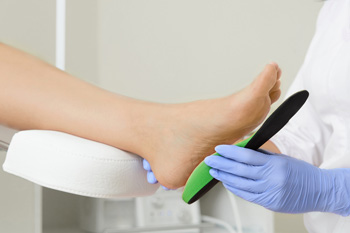 Orthotics are inserts that are worn inside of the shoes to correct issues with foot deformities, foot alignment, or to relieve pressure from various foot conditions. Orthotics can help relieve foot pain, knee pain, and lower back pain as well. There are 3 common types of orthotics including: soft, rigid, and semi-rigid. Soft orthotics are designed to cushion the foot when planted on the ground. Semi-rigid orthotics are designed to provide a middle ground between stability and cushioning and are often used for patients with flat feet. Rigid orthotics are designed to control movement in the foot that causes pain. If you believe that orthotics may be right for you, please consult with a podiatrist for professional advice. A podiatrist will custom make your orthotics to maximize your experience.
Orthotics are inserts that are worn inside of the shoes to correct issues with foot deformities, foot alignment, or to relieve pressure from various foot conditions. Orthotics can help relieve foot pain, knee pain, and lower back pain as well. There are 3 common types of orthotics including: soft, rigid, and semi-rigid. Soft orthotics are designed to cushion the foot when planted on the ground. Semi-rigid orthotics are designed to provide a middle ground between stability and cushioning and are often used for patients with flat feet. Rigid orthotics are designed to control movement in the foot that causes pain. If you believe that orthotics may be right for you, please consult with a podiatrist for professional advice. A podiatrist will custom make your orthotics to maximize your experience.
If you are having discomfort in your feet and would like to try orthotics, contact Dr. Howard Horowitz from Bowie Foot & Ankle . Our doctor can provide the care you need to keep you pain-free and on your feet.
What Are Orthotics?
Orthotics are inserts you can place into your shoes to help with a variety of foot problems such as flat feet or foot pain. Orthotics provide relief and comfort for minor foot and heel pain but can’t correct serious biomechanical problems in your feet.
Over-the-Counter Inserts
Orthotics come in a wide variety of over-the-counter inserts that are used to treat foot pain, heel pain, and minor problems. For example, arch supports can be inserted into your shoes to help correct overarched or flat feet, while gel insoles are often used because they provide comfort and relief from foot and heel pain by alleviating pressure.
Prescription Orthotics
If over-the-counter inserts don’t work for you or if you have a more severe foot concern, it is possible to have your podiatrist prescribe custom orthotics. These high-quality inserts are designed to treat problems such as abnormal motion, plantar fasciitis, and severe forms of heel pain. They can even be used to help patients suffering from diabetes by treating foot ulcers and painful calluses and are usually molded to your feet individually, which allows them to provide full support and comfort.
If you are experiencing minor to severe foot or heel pain, it’s recommended to speak with your podiatrist about the possibilities of using orthotics. A podiatrist can determine which type of orthotic is right for you and allow you to take the first steps towards being pain-free.
If you have any questions please contact our office located in Bowie, MD . We offer the newest diagnostic and treatment technologies for all your foot and ankle needs.
Foot Orthotics
Orthotics are shoe inserts that are meant to correct an irregular walking gait or provide cushioning to the feet. Orthotics come in a variety of different models and sizes, including over-the-counter and customizable variants. Customizable orthotics can be shaped and contoured to fit inside a specific shoe and are typically prescribed through a podiatrist who specializes in customized footwear and orthotics design and management.
Orthotics are beneficial because they can help prevent injuries from occurring and provide cushioning to keep pain levels down to a minimum. They also allow for the correct positioning of the feet. Orthotics can act as shock absorbers to help remove pressure from the foot and ankle. Therefore, orthotics can make bodily movements, such as walking and running, become more comfortable as well as help prevent the development of certain foot conditions.
Orthotics alleviate pain and make the foot more comfortable by slightly altering the angle at which the foot strikes the ground surface, therefore controlling the movement of the foot and ankle. Orthotics come in different variants and can be made of various materials. To determine what type of orthotic is most suited to your feet and your needs, it is best to consult your podiatrist. He or she will be able to recommend a type of orthotic that can help improve your foot function or prescribe a custom orthotic to best fit your feet.
How Seniors Can Care for Their Feet
 Because the foot is made up of 26 bones, plus a variety of tendons, ligaments, muscles and joints, proper foot care is very important. As our bodies age, the feet experience a lot of wear and tear and other chronic health conditions begin to develop. Therefore, foot care becomes even more important for seniors. Seniors should do daily foot checks to monitor sores, cracks and cuts as well as check for infections. They should also wash their feet daily and make sure that they are dried thoroughly. Keeping the toenails trimmed straight across can help to prevent ingrown toenails. Shoes should fit properly and help protect the feet from extreme hot or cold temperatures. Moisturizing cream should be used to help keep the skin soft. Seniors who are dealing with corns, calluses, bunions or any other foot related issues should visit a podiatrist for proper care.
Because the foot is made up of 26 bones, plus a variety of tendons, ligaments, muscles and joints, proper foot care is very important. As our bodies age, the feet experience a lot of wear and tear and other chronic health conditions begin to develop. Therefore, foot care becomes even more important for seniors. Seniors should do daily foot checks to monitor sores, cracks and cuts as well as check for infections. They should also wash their feet daily and make sure that they are dried thoroughly. Keeping the toenails trimmed straight across can help to prevent ingrown toenails. Shoes should fit properly and help protect the feet from extreme hot or cold temperatures. Moisturizing cream should be used to help keep the skin soft. Seniors who are dealing with corns, calluses, bunions or any other foot related issues should visit a podiatrist for proper care.
Proper foot care is something many older adults forget to consider. If you have any concerns about your feet and ankles, contact Dr. Howard Horowitz from Bowie Foot & Ankle . Our doctor can provide the care you need to keep you pain-free and on your feet.
The Elderly and Their Feet
As we age we start to notice many changes in our body, but the elder population may not notice them right away. Medical conditions may prevent the elderly to take notice of their foot health right away. Poor vision is a lead contributor to not taking action for the elderly.
Common Conditions
- Neuropathy – can reduce feeling in the feet and can hide many life-threatening medical conditions.
- Reduced flexibility – prevents the ability of proper toenail trimming, and foot cleaning. If left untreated, it may lead to further medical issues.
- Foot sores – amongst the older population can be serious before they are discovered. Some of the problematic conditions they may face are:
- Gouging toenails affecting nearby toe
- Shoes that don’t fit properly
- Pressure sores
- Loss of circulation in legs & feet
- Edema & swelling of feet and ankles
Susceptible Infections
Diabetes and poor circulation can cause general loss of sensitivity over the years, turning a simple cut into a serious issue.
If you have any questions please feel free to contact our office located in Bowie, MD . We offer the newest diagnostic and treatment technologies for all your foot and ankle needs.
Elderly Foot Care
As you grow older, you will start to notice more problems with your feet due to wear and tear. This may also happen because the skin will start to become thin and lose elasticity. Some signs of aging feet are regular aches and pains, bunion development, and clawed toes.
Fortunately, there are ways you can improve comfort, relieve pain, and maintain mobility in your feet. One of the best ways to deal with aging feet is to exercise. If you keep active, your muscles will become toned which will then strengthen the arches in the foot and stimulate blood circulation.
It is important that you practice proper foot care to protect your aging feet. You should wash your feet in warm water on an everyday basis. Afterward, the feet need to be dried well and it is important to dry between the toes. Your toenails should be trimmed and kept under control; nails that are poorly cut may become ingrown. At the end of each day, performing an inspection of your feet will allow you to detect any ailments in their early stages.
As you grow older, it becomes more important that you wear comfortable shoes. Your shoes should be secure, and they should provide decent arch support. If you are looking to buy a new pair of shoes, it is best to look for a pair that are made from a breathable material. It is also helpful to have shoes that have a bit of extra room at the top of the shoe, especially if you suffer from swollen feet.
The most common foot problems that elderly people will encounter are bunions, calluses, corns, hammertoes, heel pain, and foot problems related to diabetes. Some other issues include arch pain, tarsal tunnel syndrome, Achilles tendonitis, and Morton’s neuroma
An annual foot examination is a great way for you to ensure that you do not have any serious health problems with your feet. You should talk to a podiatrist about the available treatment options for whichever foot issue you are dealing with.
